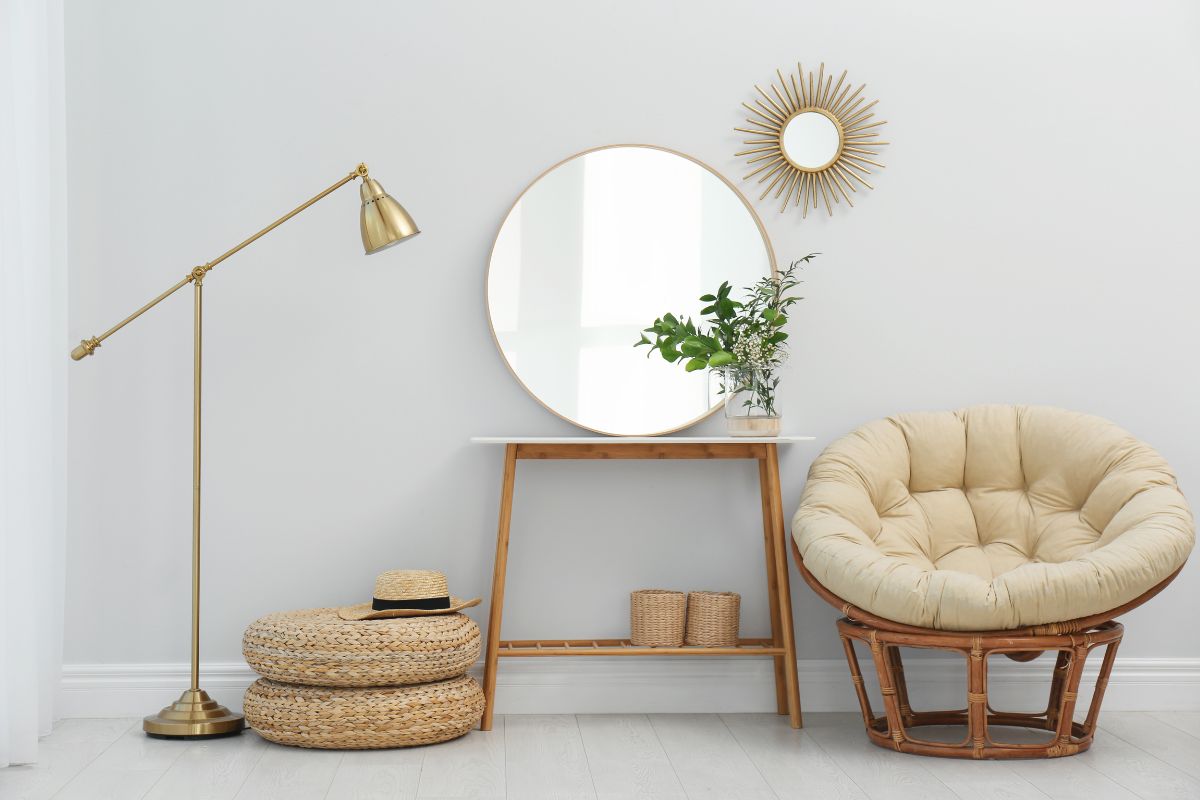By Sarah Morrissey, Founder of Cocoon Mode De Vie.
With a better understanding and more and more people’s self-awareness on wellbeing and longevity traditionally we leave the home to seek out and practice our wellbeing journey. At Cocoon Mode De Vie we focus on wellbeing beginning within the home, by applying the principals of Neuroarchitecture, the fusion of neuroscience and architecture, we seek to improve personal wellbeing by exploring the relationship and integration of Neuroscience and Architecture within our domestic environment and bringing together the four core key pillars of neuroarchitecture from neuroscience, architecture physiology and psychology wellbeing supporting our cognitive functions, our emotional wellbeing, and our overall physical and mental health by applying design in line with neuroscience principles and positive impact to our mental and psychological and physiology wellbeing.

With more of us working remotely and functioning as ‘always on’, the boundaries between work and personal life have blurred. As a result many people struggle to disconnect from work and maintain a healthy balance. It’s essential to prioritise our home environment to support overall wellbeing. Adopting neuroarchitecture in the home allows you to create a sanctuary of wellbeing, a productive, positive environment conducive to the satisfaction of various needs, thereby enriching the experience of wellbeing.
By designing and creating spaces that nurture and improve our general health, starting within the home. Indeed, by taking into consideration factors such as natural lighting, acoustics, and colour palette, neuroarchitecture can help boost concentration, memory, and learning efficiency. It can also reduce stress and anxiety and create a sense of security.
Key Benefits of Neuroarchitecture and Neuroscience Within the Home
Psychological Insights: Utilising the expertise of psychologists to understand how different spaces affect mental and emotional health, leading to designs that promote relaxation, focus, and creativity.
Design Elements: Incorporating elements such as natural light, colour psychology, and spatial arrangement to create environments that support well-being and emotional comfort.
User-Centric Spaces: With the end-user in mind, ensuring that spaces are functional, aesthetically pleasing, and conducive to a positive experience.
Sustainability Practices: Emphasising sustainable materials and building practices that not only enhance aesthetics but also contribute to the health of homeowners and their home environment.
Adaptive Features: Creating flexible communal and in the home spaces that can adapt to various needs and uses over time, ensuring longevity and relevance of the design to support their own personal wellbeing and longevity journey.
Therapeutic Environments: Designing spaces that facilitate healing and relaxation, making them suitable for therapeutic and wellness-focused purposes.
Innovative Solutions: Collaborating on cutting-edge architectural solutions that incorporate the latest research in psychology and environmental design.
Holistic Development: Fostering an integrative approach that considers both the physical and psychological aspects of the built environment, benefiting residents in multiple ways.
Research and Evaluation: Implementing research methods to assess the impact of neuroarchitecture designs on well-being, allowing for continuous improvement in design practices.
How Surroundings Can Benefit Physical and Emotional Wellbeing
Here are some key examples of how our environment and surroundings can benefit our overall physiology and psychological wellbeing whilst supporting our cognitive functions and emotional wellbeing.
Neuro-Cognitive Effects: Anterior Cingulate Cortex (ACC)
This part of the brain is crucial in regulating emotions and decision-making. When exposed to curved shapes, there’s greater activation in the ACC, suggesting that these shapes are emotionally engaging and possibly more pleasant to process than sharp or irregular shapes. The amygdala is involved in processing emotions like fear and pleasure. Greater activation in response to curves indicates that these shapes may evoke stronger emotional reactions, catching our attention more effectively than irregular windows or sharp angles.
Behavioural Effects: Approach vs. Avoidance
Brainwaves are related to spatial awareness and decision-making. Curved shapes are linked with activation patterns that favour “approach” behaviours—meaning people are more likely to be drawn to or feel comfortable in spaces with curves, as opposed to avoiding or feeling uneasy in spaces with sharp angles.
Physiological Effects: Heart Rate
Lower heart rates associated with exposure to curved shapes indicate a calming effect, which contrasts with the stress or arousal that might accompany sharp, irregular shapes. This physiological response supports the preference for curves, as they are less likely to induce anxiety or stress.
These findings suggest that environments with curved shapes are not only more aesthetically pleasing but also create a psychological and physiological sense of comfort and approachability. This knowledge is often applied in architecture and design to create spaces that promote well-being and positive interaction.
Textures & Materials
The study of textures and materials, particularly natural ones like wood, has insightful effects on human responses.
Physiological Effects
- Heart Rate & Sweat Response: Natural materials like wood can lower heart rate and reduce sweat responses, even when individuals aren’t consciously aware of the texture. This indicates a calming effect similar to a mild stress reliever.
- Vision Adjustment: Natural textures help with eye strain by improving near-distance vision. This is particularly beneficial for individuals with myopia, enhancing their visual comfort and performance after extended work periods.
Neuro-Cognitive Effects
- Coherence & Focus: Spaces that feature natural wood textures show greater coherence in cognitive responses. This means such environments can enhance focus and information retention, making square wooden spaces conducive to learning and productivity.
Emotional Effects
- Relaxation & Comfort: Environments incorporating natural materials like wood provide a relaxed and comfortable atmosphere. This emotional response can enhance overall well-being, making wooden designs preferred in many settings.
- Satisfaction with soft fabrics: Specifically mentioned is carpet material which boosts satisfaction. This suggests that soft, tactile materials contribute to comfort and well-being.
In essence, incorporating natural materials in design not only elevates aesthetic appeal but also has a profound impact on physiological, cognitive, and emotional wellbeing.
At Cocoon Mode de Vie, our team of experts in design, cognitive therapy, and specialized therapy harness neuroarchitecture to enhance cognitive function and emotional wellbeing.
About the expert
 Sarah Morrisey is the visionary founder of Cocoon Mode De Vie, a pioneering wellness brand that merges design, cognitive therapy, and neuroarchitecture to enhance emotional well being and cognitive function. With a career spanning nearly two decades in investment banking, Sarah’s journey into the wellness space was shaped by a deep-rooted passion for movement, nutrition, and holistic living. Originally set to lead a world renowned London spa upon arriving in the UK in 2005, life circumstances led Sarah to pivot into finance, where she spent 18 years navigating high performance corporate environments. However, a life altering car accident became the catalyst for change, prompting her to realign with her true calling—creating spaces that nurture both mental and physical well-being.
Sarah Morrisey is the visionary founder of Cocoon Mode De Vie, a pioneering wellness brand that merges design, cognitive therapy, and neuroarchitecture to enhance emotional well being and cognitive function. With a career spanning nearly two decades in investment banking, Sarah’s journey into the wellness space was shaped by a deep-rooted passion for movement, nutrition, and holistic living. Originally set to lead a world renowned London spa upon arriving in the UK in 2005, life circumstances led Sarah to pivot into finance, where she spent 18 years navigating high performance corporate environments. However, a life altering car accident became the catalyst for change, prompting her to realign with her true calling—creating spaces that nurture both mental and physical well-being.
Through Cocoon Mode De Vie, Sarah champions a science-backed approach to wellness, integrating neuroarchitecture to transform homes into sanctuaries that support overall health and longevity. She is dedicated to helping individuals achieve balance, resilience, and vitality by fostering environments that promote self-care from the inside out.
For more information, please visit cocoonmdv.com


